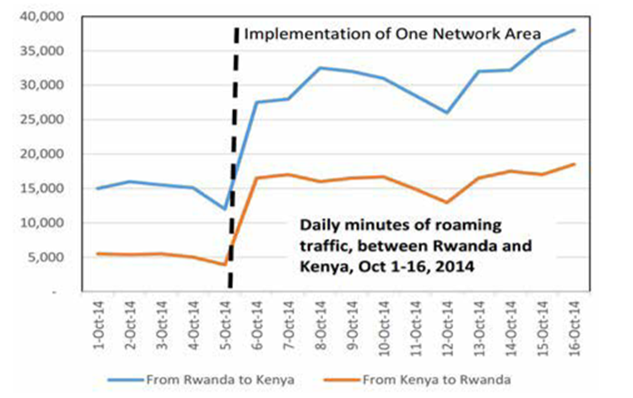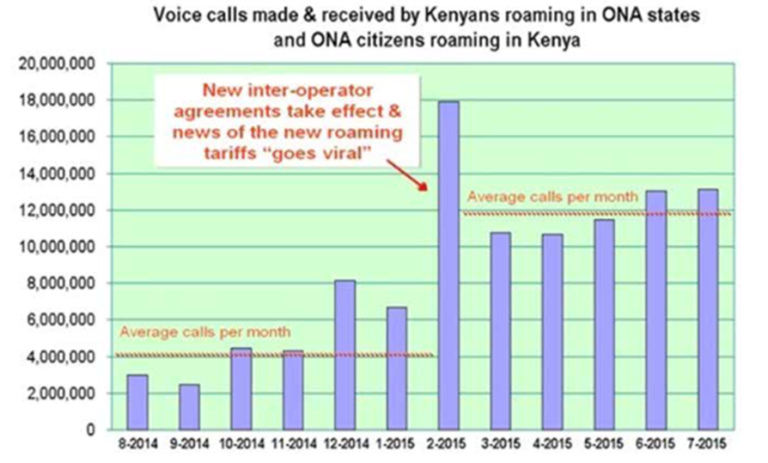The East Africa One Network Area is a multi-country initiative created to enable a harmonious environment in the international roaming market, through the provision of affordable telecommunication services. The African Union (AU) commission notes that the East African Community is the most advanced regional community. The 2019 Africa Regional Integrated Index (ARII) ranked the East Africa Community as the highest scoring bloc, based on metrics that track the implementation and fulfillment of regional integration objectives. These metrics include; the free movement of people, infrastructure, macroeconomic, productive and trade integration. Focusing on infrastructure integration, member states of the East African Community acknowledge that linking different infrastructural developments has the potential to boost national and regional economies hence improving the socio-economic aspects of approximately 170 million people. Investments in telecommunication, which is part of the overall infrastructure development agenda, enables a seamless and cost-effective way of relaying information across the region through mobile and internet connectivity. According to findings from GSMA, the Sub-Saharan Africa region projects a subscriber penetration and a smartphone adoption rate from 46% in 2020 to 50% in 2025 and 48% in 2020 to 64% in 2025 respectively. For EAC member states, mobile phone subscription rates have grown steadily as overall population grows. This has resulted in a phenomenal information value-chain exposure that has increased the chances of positioning a competitive African and global niche, especially through the ratification of the One Network Area, which is one of the efforts by the East Africa Community member states.
Therefore, what changes has the one network area brought to the various economic actors within the EAC? Say Mr Mutua is a businessperson, selling textile in Kenya. He seeks to expand his operations to Rwanda and Uganda. Presently while conducting his market research in the two countries, Mr Mutua is able to affordably access and exploit call and bulk SMS services that aid in his R&D programs, which would have otherwise been very expensive and downright frustrating. This basic example explains how the One Network Area directly affects certain economic and business plans for SMEs in member states that have adopted this protocol.
Telecommunication services and mobile connectivity have contributed to economic growth over the years. In retrospect, this was not always seamless. The different mobile providers and radio bands have had a diverse impact on communication in different areas. Licensed by national regulators of their host country, authorization on mobile network coverage was limited to national borders. This had a negative influence on the business costing and pricing models on enterprises such as Mr Mutua’s. This changed when the governments of Tanzania, Uganda and Kenya issued international gateway licenses. Airtel (then Celtel) was the first to integrate its cellular coverage in the member states and offer its services at domestic prices. The liberalization eventually facilitated substitutional networks like Vodacom, Safaricom and MTN to follow suit.

Formed in 2014, the One Network Area was created with the anticipation that the region would experience increase in trade margins, enhance integration and aim to reduce the cost of doing business. This is to be achieved through enhancing collaborative regulatory measures that mandated EAC member states to: eliminate charges for receiving voice calls while roaming in Kenya, Rwanda, South Sudan and Uganda, waiver excise taxes and surcharges on incoming ONA voice traffic while establishing wholesale and retail price caps on outbound ONA traffic and requiring mobile network operators (MNO) to re-negotiate with their roaming partners to reduce wholesale tariffs. True to that word, ONA’s tariff impact on voice roaming traffic in Kenya and Rwanda demonstrated a significant increase in talk-time while Tanzania experienced a 68% drop in mobile tariffs after the de-monopolization.

The impact of lower tariffs on individual roamers has been significantly influential since ONA implementation. ONA has benefited the public directly through reducing the cost of mobile communication. The Communication Authority of Kenya shared the trend above, depicting a steady growth of voice calls made in Kenya from an average of 4million before ONA ratification to 12 million after ratification of the agreement. Outgoing roaming traffic between Uganda and Rwanda averaged 1.5 million in 2014 pre-ratification to 7 million in 2015 post-ratification. Although the benefits of ONA have been extended to South Sudan, the country is yet to set up appropriate stable infrastructure and policies that would push towards the realization and utilization of ONA’s potential. So far, the country’s outgoing roaming traffic to Kenya has grown exceptionally by 109% mainly driven by a growing investment appetite between the two countries. The affordability and accessibility of mobile related services in EAC brought about by the one network area stands to deepen regional trade and integration and promote economic development in EAC states.

Miss Kamuu Nyingi is a professional accountant, writer and futurist who possesses a strong desire to understand, simplify and share the interlinkages of various phenomenon and concepts surrounding our lives.
No related posts.

